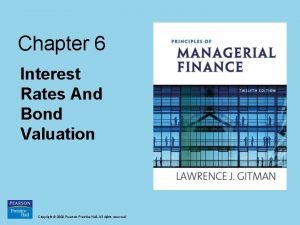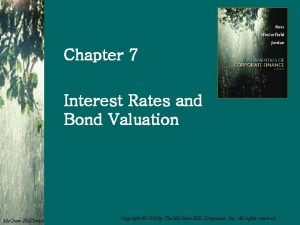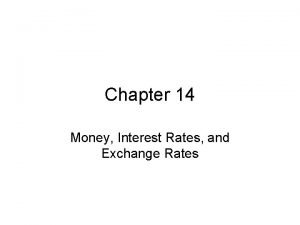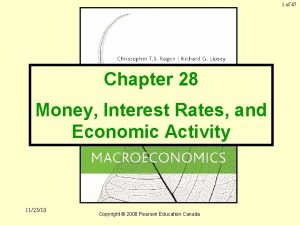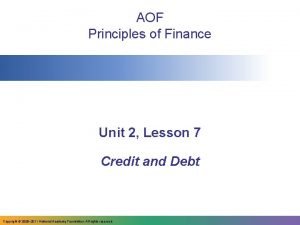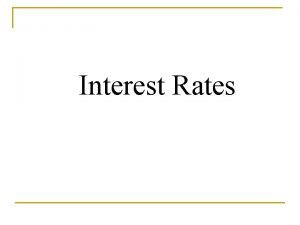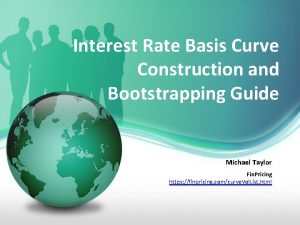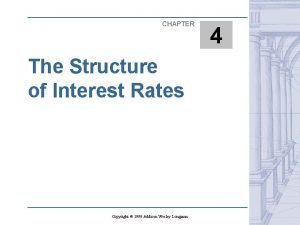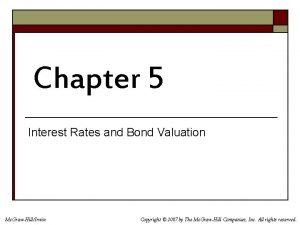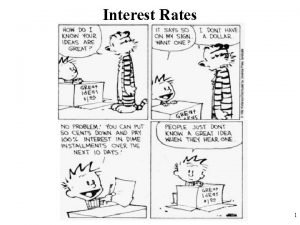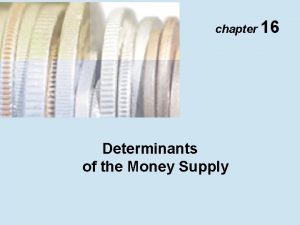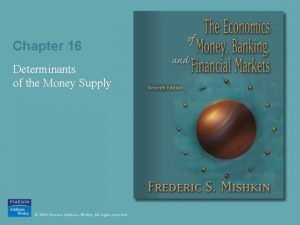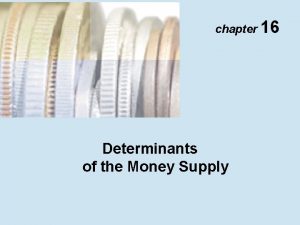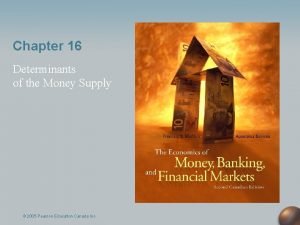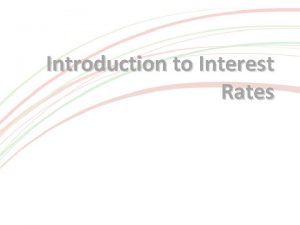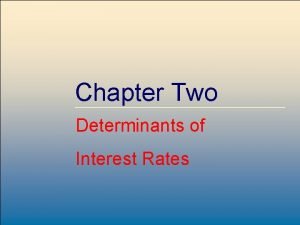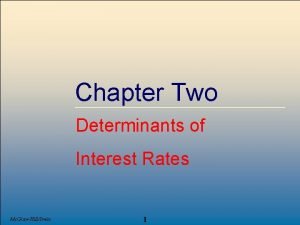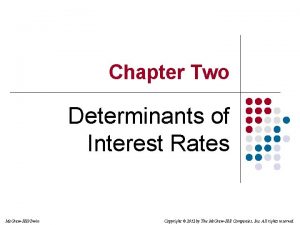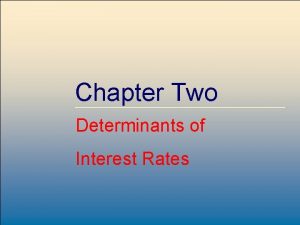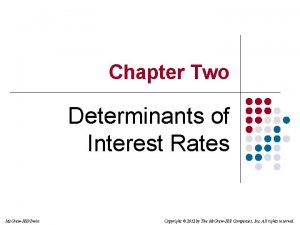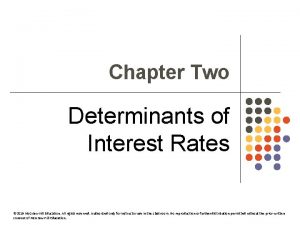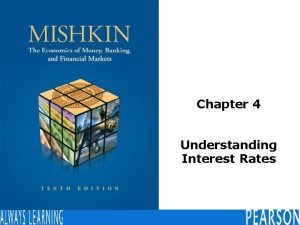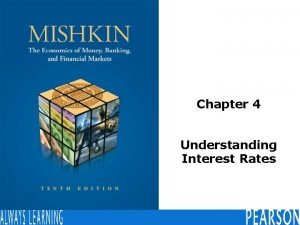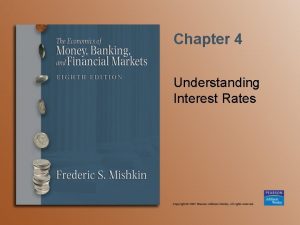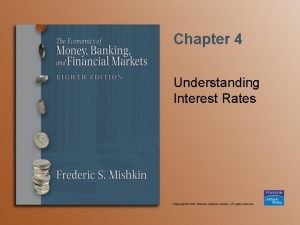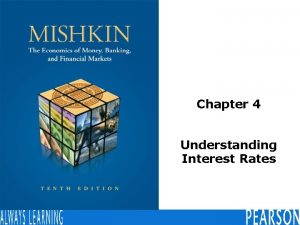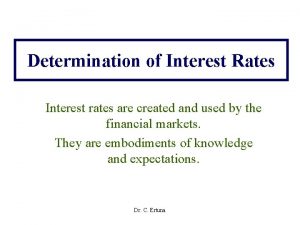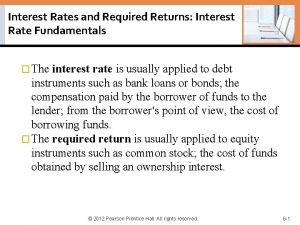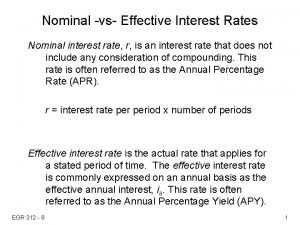Chapter Two Determinants of Interest Rates Interest Rate































- Slides: 31

Chapter Two Determinants of Interest Rates

Interest Rate Fundamentals l Nominal interest rates: the interest rates actually observed in financial markets l l Used to determine fair present value and prices of securities Two components: l Opportunity cost l Adjustments for individual security characteristics © 2019 Mc. Graw-Hill Education. All rights reserved. Authorized only for instructor use in the classroom. No reproduction or further distribution permitted without the prior written consent of Mc. Graw-Hill Education.

Loanable Funds Theory l l l Loanable funds theory explains interest rates and interest rate movements Views level of interest rates as resulting from factors that affect the supply of and demand for loanable funds Categorizes financial market participants – e. g. , consumers, businesses, governments, and foreign participants – as net suppliers or demanders of funds © 2019 Mc. Graw-Hill Education. All rights reserved. Authorized only for instructor use in the classroom. No reproduction or further distribution permitted without the prior written consent of Mc. Graw-Hill Education.

Supply and Demand for Loanable Funds Interest Rate Demand Supply Quantity of Loanable Funds Supplied and Demanded © 2019 Mc. Graw-Hill Education. All rights reserved. Authorized only for instructor use in the classroom. No reproduction or further distribution permitted without the prior written consent of Mc. Graw-Hill Education.

Key Interest Rates Over Time © 2019 Mc. Graw-Hill Education. All rights reserved. Authorized only for instructor use in the classroom. No reproduction or further distribution permitted without the prior written consent of Mc. Graw-Hill Education.

Net Supply & Demand of Funds in U. S. in 2016 © 2019 Mc. Graw-Hill Education. All rights reserved. Authorized only for instructor use in the classroom. No reproduction or further distribution permitted without the prior written consent of Mc. Graw-Hill Education.

Determinants of Household Savings 1. 2. 3. 4. 5. Interest rates and tax policy Income and wealth: the greater the wealth or income, the greater the amount saved Attitudes about saving versus borrowing Credit availability: the greater the amount of easily obtainable consumer credit the lower the need to save Job security and belief in soundness of entitlements © 2019 Mc. Graw-Hill Education. All rights reserved. Authorized only for instructor use in the classroom. No reproduction or further distribution permitted without the prior written consent of Mc. Graw-Hill Education.

Determinants of Foreign Funds Invested in the U. S. 1. 2. 3. 4. Relative interest rates and returns on global investments Expected exchange rate changes Safe haven status of U. S. investments Foreign central bank investments in the U. S. © 2019 Mc. Graw-Hill Education. All rights reserved. Authorized only for instructor use in the classroom. No reproduction or further distribution permitted without the prior written consent of Mc. Graw-Hill Education.

Federal Government Demand for Funds Concluded l Governments borrow heavily in the markets for loanable funds l l $23. 19 trillion in 2016 United States l National debt was $19. 21 trillion in 2016 l National debt (and interest payments on the national debt) have to be financed in large part by additional borrowing © 2019 Mc. Graw-Hill Education. All rights reserved. Authorized only for instructor use in the classroom. No reproduction or further distribution permitted without the prior written consent of Mc. Graw-Hill Education.

Business Demand for Funds l Level of interest rates: l l Expected future profitability vs. risk: l l When the cost of loanable funds is high (i. e. , interest rates are high), businesses finance internally The greater the number of profitable projects available to businesses, the greater the demand for loanable funds Expected economic growth © 2019 Mc. Graw-Hill Education. All rights reserved. Authorized only for instructor use in the classroom. No reproduction or further distribution permitted without the prior written consent of Mc. Graw-Hill Education.

Effect on Interest Rates from a Shift in the Supply Curve for Loanable Funds © 2019 Mc. Graw-Hill Education. All rights reserved. Authorized only for instructor use in the classroom. No reproduction or further distribution permitted without the prior written consent of Mc. Graw-Hill Education.

Effect on Interest Rates from a Shift in the Demand Curve for Loanable Funds © 2019 Mc. Graw-Hill Education. All rights reserved. Authorized only for instructor use in the classroom. No reproduction or further distribution permitted without the prior written consent of Mc. Graw-Hill Education.

Factors that Affect the Supply of and Demand for Loanable Funds for a Financial Security © 2019 Mc. Graw-Hill Education. All rights reserved. Authorized only for instructor use in the classroom. No reproduction or further distribution permitted without the prior written consent of Mc. Graw-Hill Education.

Determinants of Interest Rates for Individual Securities ij* = f(IP, RFR, DRPj, LRPj, SCPj, MPj) l Inflation (IP) IP = [(CPIt+1 – CPIt)/CPIt] x 100 l Real risk-free interest rate (RFR) and the Fisher effect RFR = i – Expected (IP) © 2019 Mc. Graw-Hill Education. All rights reserved. Authorized only for instructor use in the classroom. No reproduction or further distribution permitted without the prior written consent of Mc. Graw-Hill Education.

Determinants of Interest Rates for Individual Securities Continued l Default risk premium (DRP) DRPj = ijt – i. Tt ijt = interest rate on security issued by a non. Treasury issuer (issuer j) of maturity m at time t i. Tt = interest rate on security issued by the U. S. Treasury of maturity m at time t l l l Liquidity risk (LRP) Special provisions (SCP) Term to maturity (MP) © 2019 Mc. Graw-Hill Education. All rights reserved. Authorized only for instructor use in the classroom. No reproduction or further distribution permitted without the prior written consent of Mc. Graw-Hill Education.

DRPs Over Time © 2019 Mc. Graw-Hill Education. All rights reserved. Authorized only for instructor use in the classroom. No reproduction or further distribution permitted without the prior written consent of Mc. Graw-Hill Education.

Unbiased Expectations Theory l Current long-term interest rates (1 RN) are geometric averages of current and expected future, E(Nr 1), short-term interest rates 1 R N = actual N-period rate today N = term to maturity, N = 1, 2, …, 4, … 1 R 1 = actual current one-year rate today E(ir 1) = expected one-year rates for years, i = 1 to N © 2019 Mc. Graw-Hill Education. All rights reserved. Authorized only for instructor use in the classroom. No reproduction or further distribution permitted without the prior written consent of Mc. Graw-Hill Education.

Liquidity Premium Theory l Long-term interest rates are geometric averages of current and expected future short-term interest rates plus liquidity risk premiums that increase with maturity Lt = liquidity premium for period t L 2 < L 3 < …LN © 2019 Mc. Graw-Hill Education. All rights reserved. Authorized only for instructor use in the classroom. No reproduction or further distribution permitted without the prior written consent of Mc. Graw-Hill Education.

Market Segmentation Theory l l l Individual investors and FIs have specific maturity preferences Interest rates are determined by distinct supply and demand conditions within many maturity segments Investors and borrowers deviate from their preferred maturity segment only when adequately compensated to do so © 2019 Mc. Graw-Hill Education. All rights reserved. Authorized only for instructor use in the classroom. No reproduction or further distribution permitted without the prior written consent of Mc. Graw-Hill Education.

Implied Forward Rates l l A forward rate (f) is an expected rate on a shortterm security that is to be originated at some point in the future The one-year forward rate for any year, N years into the future is: © 2019 Mc. Graw-Hill Education. All rights reserved. Authorized only for instructor use in the classroom. No reproduction or further distribution permitted without the prior written consent of Mc. Graw-Hill Education.

The Interest Rate Which would you prefer -- $10, 000 today or $10, 000 in 5 years? years Obviously, $10, 000 today You already recognize that there is TIME VALUE TO MONEY!! MONEY

Why TIME? Why is TIME such an important element in your decision? TIME allows you the opportunity to postpone consumption and earn INTEREST

Types of Interest u Simple Interest earned only on the original investment; no interest is earned on interest. l Compound Interest earned on any previous interest earned, as well as on the principal borrowed (lent).

Future Value (U. S. Dollars) Why Compound Interest?

Future Values Future Value: Amount to which an investment will grow after earning interest. Let r = annual interest rate Let t = time (years) Simple Interest Compound Interest

Compare the interest earned from an investment 125£ for 10 years at 12% simple Simple interest with that earned by. Compound the same amount for 10 years at 12 % compounded annually? = 125*(1+12%*10) =275 275 -125=150 =125*(1+12%)^10 =388 388 -125=263 Interest on interest: 263 -150= 113

Relation between Interest Rates and Present and Future Values Present Value (PV) Future Value (FV) Interest Rate © 2019 Mc. Graw-Hill Education. All rights reserved. Authorized only for instructor use in the classroom. No reproduction or further distribution permitted without the prior written consent of Mc. Graw-Hill Education.

INTEREST SYSTEM ØPresent Value or ØPrincipal (P or PV) ØAnnuities (A) Rate (r) Periods (t) ØFuture Value (FV) Interest: The PRICE of the MONEY

Annuities l Annuity: a sequence of equal cash flows, occurring at the end of each period. This is known as an ordinary annuity. 0 PV 1 2 3 4 FV 29

Example of an Ordinary Annuity -FVA Cash flows occur at the end of the period 0 1 2 3 $1, 000 7% 4 $1, 070 $1, 145 FVA 3 = $1, 000(1. 07)2 + $1, 000(1. 07)1 + $1, 000(1. 07)0 = $1, 145 + $1, 070 + $1, 000 = $3, 215 = FVA 3

Example of an Ordinary Annuity -PVA Cash flows occur at the end of the period 0 1 2 3 $1, 000 7% $934. 58 $873. 44 $816. 30 $2, 624. 32 = PVA 3 = 4 $1, 000/(1. 07)1 + $1, 000/(1. 07)2 + $1, 000/(1. 07)3 = $934. 58 + $873. 44 + $816. 30 = $2, 624. 32
 Determinants of interest rates
Determinants of interest rates Real vs nominal interest rate
Real vs nominal interest rate What is a unit ratio
What is a unit ratio Ratio guided notes
Ratio guided notes Ratios rates and unit rates
Ratios rates and unit rates Ratios rates and unit rates
Ratios rates and unit rates Chapter 7 interest rates and bond valuation
Chapter 7 interest rates and bond valuation Chapter 5 bonds bond valuation and interest rates solutions
Chapter 5 bonds bond valuation and interest rates solutions Chapter 6 interest rates and bond valuation
Chapter 6 interest rates and bond valuation Chapter 7 interest rates and bond valuation
Chapter 7 interest rates and bond valuation Chapter 6 interest rates and bond valuation
Chapter 6 interest rates and bond valuation Cap rate interest rate relationship
Cap rate interest rate relationship Interest rates and economic growth
Interest rates and economic growth Loanable funds graph recession
Loanable funds graph recession Financial risk definition
Financial risk definition Interest rates quotes
Interest rates quotes Interest rates and price level
Interest rates and price level Interest rates and price level
Interest rates and price level Nominal interest rate
Nominal interest rate Economics unit 2 lesson 7
Economics unit 2 lesson 7 Interest rates
Interest rates Interest rate curve construction
Interest rate curve construction Interest rates
Interest rates Interest rates
Interest rates Rise in interest rates effects
Rise in interest rates effects When the learner is receptive to learning.
When the learner is receptive to learning. Chapter 16 determinants of the money supply
Chapter 16 determinants of the money supply Chapter 16 determinants of the money supply
Chapter 16 determinants of the money supply Chapter 16 determinants of the money supply
Chapter 16 determinants of the money supply The formula for the simple deposit multiplier is
The formula for the simple deposit multiplier is Two opposing processes occur at equal rates
Two opposing processes occur at equal rates 0 965
0 965








